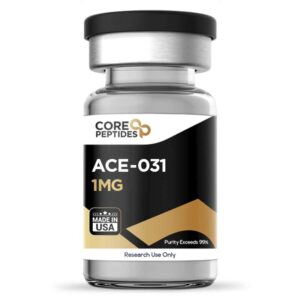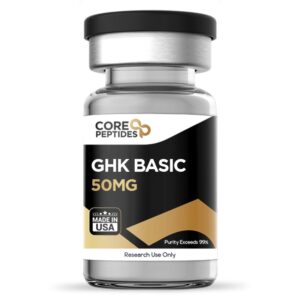Description
Lipopeptide (Palmitoyl-Gly-Gln-Pro-Arg)
Lipopeptide, often referred to as Pal-GQPR or Palmitoyl Tetrapeptide-7/3, is a synthetic palmitoylated peptide fragment derived from immunoglobulin G (IgG). IgG is a major antibody class that plays a central role in immune responses and inflammatory regulation. Lipopeptide is structurally modified by the attachment of a palmitic acid moiety, a lipid component that enhances its ability to penetrate skin layers, particularly through lipid-rich environments such as the stratum corneum, thereby improving its experimental and therapeutic potential in dermatological applications.
Chemical Properties
-
Sequence: Palmitoyl-Gly-Gln-Pro-Arg
-
Molecular Formula: C38H68N6O8
-
Molecular Weight: 736.9 g/mol
-
Other Names: Pal-GQPR, Palmitoyl Tetrapeptide-7/3
-
Class: Lipopeptide, matrikine-like synthetic peptide
The palmitoylation provides increased stability against proteolytic degradation and facilitates transdermal delivery, making it suitable for topical applications aimed at skin repair, anti-aging, and modulation of inflammatory responses.
Mechanism of Action
-
Modulation of Inflammation
-
Lipopeptide is suggested to reduce pro-inflammatory cytokine secretion, particularly interleukin-6 (IL-6). IL-6 is elevated in inflammatory skin conditions and following UVB radiation, contributing to skin aging and damage.
-
By suppressing IL-6, Lipopeptide may help mitigate inflammatory responses, protecting skin structure and function.
-
-
Extracellular Matrix Support
-
Lipopeptide appears to stimulate the synthesis of structural proteins critical for the dermal and epidermal matrix, including:
-
Laminin IV and V: Key components of the basement membrane supporting cell adhesion, differentiation, and migration.
-
Collagen VII: Integral for anchoring fibrils that attach the epidermis to the dermis, promoting structural stability.
-
-
This stimulation may improve skin firmness, elasticity, and overall dermal integrity.
-
-
Photoaged Skin Repair
-
Studies have suggested that Lipopeptide promotes the deposition of fibrillin-1, a protein involved in microfibril formation in the dermis.
-
Increased fibrillin-1 correlates with structural remodeling of photoaged skin, potentially reducing wrinkles and improving skin texture.
-
In long-term studies, Lipopeptide-containing formulations were shown to improve the appearance of fine lines, wrinkles, and overall skin elasticity, with effects becoming more pronounced after months of continuous use.
-
Research and Clinical Findings
-
Extracellular Dermal Matrix Enhancement
-
In vivo and in vitro studies using echography and histology demonstrated that Lipopeptide could increase dermal density and reduce the thickness of the subepidermal low-echogenic band.
-
These changes indicate a reinforcement of skin architecture and potential anti-aging benefits.
-
-
Anti-Inflammatory Effects
-
Preliminary studies reported that Lipopeptide may suppress IL-6 secretion following UV exposure, suggesting protective activity against photoinduced inflammation.
-
By modulating inflammatory pathways, the peptide could reduce skin redness, sensitivity, and damage, contributing to healthier skin over time.
-
-
Skin Repair and Anti-Aging
-
In randomized controlled trials (RCTs), Lipopeptide enhanced fibrillin-1 deposition in the papillary dermis, which is essential for maintaining elasticity and structural support.
-
Compared to placebo or vehicle formulations, Lipopeptide was associated with:
-
Reduced depth and visibility of wrinkles
-
Improved skin texture
-
Enhanced dermal resilience in photoaged skin
-
-
These effects were comparable to standard clinical treatments, such as all-trans retinoic acid, but with potentially lower irritation.
-
-
Long-Term Effects
-
Studies indicate that continued use of Lipopeptide over months can result in progressive improvement in skin firmness, elasticity, and overall appearance.
-
Data suggest cumulative benefits for photoaged and structurally weakened skin, making it a candidate for long-term anti-aging formulations.
-
Potential Applications
-
Cosmetic Dermatology: Anti-aging creams, serums, and treatments targeting wrinkles and sagging skin.
-
Skin Repair: Post-UV exposure recovery, reinforcement of dermal extracellular matrix, wound healing adjuncts.
-
Inflammation Modulation: Reducing pro-inflammatory cytokines in sensitive or aging skin.
Summary
Lipopeptide (Pal-GQPR) is a palmitoylated tetrapeptide derived from IgG with promising experimental applications in skin repair, anti-aging, and anti-inflammatory regulation. Its mechanisms involve enhancing dermal extracellular matrix proteins, reducing inflammation, and promoting fibrillin-1 deposition, which collectively support skin structure, elasticity, and resilience. Preliminary studies and clinical trials suggest that long-term application may improve skin firmness, reduce wrinkles, and restore photoaged skin, making it a notable peptide in cosmetic and dermatological research.
References:
-
Mondon, P., Hillion, M., Peschard, O., et al. Evaluation of dermal extracellular matrix and epidermal-dermal junction modifications using MALDI imaging, reflectance confocal microscopy, echography, and histology: effect of age and peptide applications. Journal of Cosmetic Dermatology, 14(2), 152–160. https://doi.org/10.1111/jocd.12135
-
Resende, D. I. S. P., Ferreira, M. S., Sousa-Lobo, J. M., et al. Usage of Synthetic Peptides in Cosmetics for Sensitive Skin. Pharmaceuticals (Basel), 14(8), 702. https://doi.org/10.3390/ph14080702
-
Fadilah, N. I. M., Rahman, M. B. A., Yusof, L. M., et al. The Therapeutic Effect and In Vivo Assessment of Palmitoyl-GDPH on the Wound Healing Process. Pharmaceutics, 13(2), 193. https://doi.org/10.3390/pharmaceutics13020193
-
Watson, R. E., Ogden, S., Cotterell, L. F., et al. Effects of a cosmetic ‘anti-ageing’ product improves photoaged skin. British Journal of Dermatology, 2009.





Reviews
There are no reviews yet.